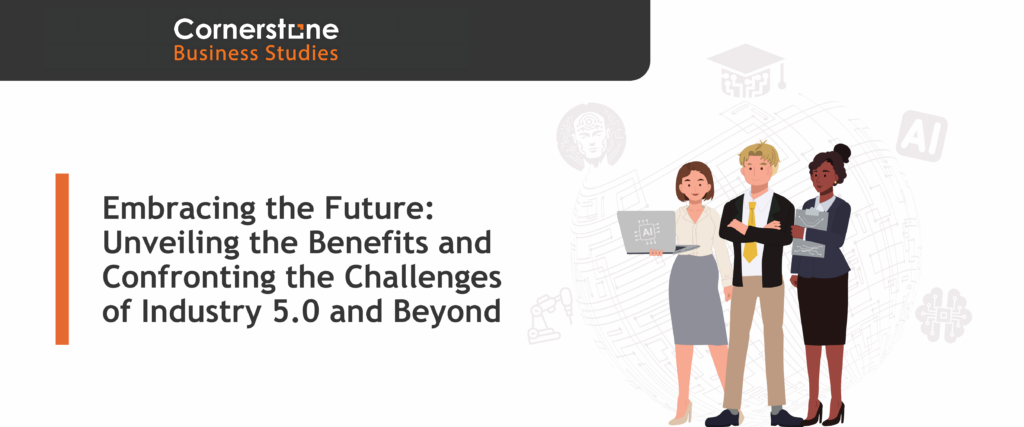Embracing the Future: Unveiling the Benefits and Confronting the Challenges of Industry 5.0 and Beyond

Industry 4.0 has become synonymous with the ongoing digital transformation, revolutionising manufacturing and other industries worldwide. But looking beyond Industry 4.0, what can we anticipate in the next industrial revolutions?
Industry 5.0, also known as the human-tech partnership, is a revolutionary advancement in the industrial sector that combines the benefits of Industry 4.0 with the human touch. It emphasises human creativity, innovation, problem-solving skills, productivity, job satisfaction, and social responsibility, while utilising advanced technologies, i.e. Industry 5.0 aims to create a work environment where machines perform repetitive tasks while humans focus on complex, creative work.
The emergence of Industry 5.0 principles is already underway, where the more widespread adoption of Industry 5.0 concepts is expected by the late 2020s. By the 2030s, Industry 5.0 is expected to be firmly entrenched in industrial practices across multiple sectors.
This need for Industry 5.0 is driven by global market competition and the increasing demand for efficiency, productivity, and quality. More specifically, in manufacturing, notable areas of benefit are the following:
- Industry 5.0 for Smarter Manufacturing aims to balance intelligent robots and people, utilising human creativity, teamwork, and ethical concerns. This approach satisfies sustainable development goals related to manufacturing and opens new avenues for innovation, customisation, and personalisation across various sectors, making it the Smarter Manufacturing route.
- Industry 5.0 is value-centric, highlighting trust, mass personalisation, and autonomy as key factors in user expectations. The integrated use of IoT, AI, cobots, and augmented reality (AR), virtual reality (VR), and mixed reality (MR) can mitigate the negative effects of macro-level elements such as financial crises, pandemics, population ageing and climate change.
- Industry 5.0 has the potential to advance sustainable manufacturing by integrating value networks, promoting sustainable technology governance, fostering business model innovation, and fostering sustainable skill development.
- Industry 5.0 promotes an integrated approach to sustainable innovation, emphasising ethical considerations throughout the technology development life cycle. VR and artificial intelligence (AI) technologies applied in product ideation can enhance creative situations in engineering, where the designers’ creative experience is enhanced.
- The role of digital twin (DT) technology in Industry 5.0 is frequently highlighted, in meeting new industrial, social, and environmental needs. DT is essential for creating value, reducing time-to-market, optimising plant equipment, and providing unique insights. As costs decrease, suppliers increase, and advanced technologies become available, integrating DT should be a necessary step for global manufacturers.
- Safety management is crucial for human-centred manufacturing in Industry 5.0. Here, the challenges of understanding complex interactions of human-machine-environmental activities, understanding the causality of unsafe conditions, and adapting safety management methods must be addressed. A reasoning approach based on Digital Twin is proposed to meet these challenges.
However, as we stand at the vanguard of Industry 5.0, it is crucial to look beyond the immediate horizon and anticipate the trajectory of future advancements. Beyond 2030, it is expected that Industry 6.0 will be characterised by advanced technologies like quantum computing, nanotechnology, multidimensional printing, biotechnology, robotic medical systems, assistive home-robotics, deep dive electroencephalograms (EEGs), and aerial manufacturing platforms that aim to tackle complex problems, create novel materials, devices, and systems for improvements in production and quality of life.
Consequently, Industry 5.0 and 6.0 both have and will have a profound impact on employment. The importance of identifying and developing the right specialist and technical skills for the workforce cannot be over-emphasised. Increasing digitalisation, automation and Industry 4.0 technologies are forcing the workforce, especially the aging workforce, to change how they complete ordinary tasks and allowing them to spend more time on activities that add value.
In this regard, several critical skills can be identified, for example:
- Digital literacy – proficiency in using digital tools and technologies, e.g., AI, dashboards and robotics
- Data analysis and interpretation – ability to collect, analyse, and derive insights from large volumes of data generated by connected devices and sensors is crucial for informed decision-making.
- Programming and coding – knowledge of programming languages is valuable for developing and maintaining software applications, IIoT devices, and automation systems.
- Adaptability and continuous learning – given the rapid pace of technological advancements, individuals need to be adaptable and open to learning new skills to stay relevant in their roles, i.e., having a growth mindset
- Collaboration, communication and cultural competence – emerging technology projects often require collaboration across different departments and disciplines; the ability to work effectively in interdisciplinary teams and communicate complex ideas is essential and work effectively and safely with cobots.
- Critical thinking and problem-solving – strong analytical and problem-solving skills are needed to identify, troubleshoot, and resolve issues related to technology implementation and process optimisation.
- Creativity and innovation – thinking creatively to develop innovative solutions and approaches for improving efficiency, productivity, and product quality continues to be highly valued.
To conclude, Industry 4.0 has laid the groundwork for unprecedented advancements expected in the next industrial revolutions, where through innovation, collaboration and adaptation, Industry 5.0 and 6.0 offer opportunities for an improved, sustainable and prosperous future.
This makes us change how we think about employment and the economy, how roles within the workforce will continue to be reimagined and redefined, and how access to the right talent and skills will enable faster adoption of these new emerging technologies.
Sharon Brand
Department of Business Studies, Cornerstone Institute
References:
De Felice, F. & Petrillo, A. 2023. Special Issue “Smart Manufacturing Systems for Industry 5.0: Challenges and Opportunities”. Applied Sciences (Switzerland). 13(11):10–12. DOI: 10.3390/app13116397.
Duggal, A.S., Malik, P.K., Gehlot, A., Singh, R., Gaba, G.S. & Masud, M. 2022. A sequential roadmap to Industry 6.0: Exploring future manufacturing trends. IET Communications. 16(5):1–20. DOI: http://dx.doi.org.ez.sun.ac.za/10.1049/cmu2.12284.
Enang, E., Bashiri, M. & Jarvis, D. 2023. Exploring the transition from techno centric industry 4.0 towards value centric industry 5.0: a systematic literature review. International Journal of Production Research. 61(22):7866–7902. DOI: 10.1080/00207543.2023.2221344.
Ghobakhloo, M., Iranmanesh, M., Foroughi, B., Babaee Tirkolaee, E., Asadi, S. & Amran, A. 2023. Industry 5.0 implications for inclusive sustainable manufacturing: An evidence-knowledge-based strategic roadmap. Journal of Cleaner Production. 417(April):138023. DOI: 10.1016/j.jclepro.2023.138023.
Grech, A., Mehnen, J. & Wodehouse, A. 2023. An Extended AI-Experience: Industry 5.0 in Creative Product Innovation. Sensors. 23(6). DOI: 10.3390/s23063009.
Huang, S., Wang, B., Li, X., Zheng, P., Mourtzis, D. & Wang, L. 2022. Industry 5.0 and Society 5.0—Comparison, complementation and co-evolution. Journal of Manufacturing Systems. 64(June):424–428. DOI: 10.1016/j.jmsy.2022.07.010.
Ivanov, D. 2023. The Industry 5.0 framework: viability-based integration of the resilience, sustainability, and human-centricity perspectives. International Journal of Production Research. 61(5):1683–1695. DOI: 10.1080/00207543.2022.2118892.
Leng, J., Sha, W., Wang, B., Zheng, P., Zhuang, C., Liu, Q., Wuest, T., Mourtzis, D., et al. 2022. Industry 5.0: Prospect and retrospect. Journal of Manufacturing Systems. 65(October):279–295. DOI: 10.1016/j.jmsy.2022.09.017.
Lv, Z. 2023. Digital Twins in Industry 5.0. Research. 6. DOI: 10.34133/research.0071.
Martínez-gutiérrez, A., Díez-gonzález, J., Perez, H., Araújo, M., Duggal, A.S., Malik, P.K., Gehlot, A., Singh, R., et al. 2024. Industry 5.0: Prospect and retrospect. Robotics and Computer-Integrated Manufacturing. 16(September):279–295. DOI: 10.1049/cmu2.12284.
Modgil, S., Singh, R.K. & Agrawal, S. 2023. Developing human capabilities for supply chains: an industry 5.0 perspective. Springer US. DOI: 10.1007/s10479-023-05245-1.
Nodia. 2023. Merging Minds and Machines: Unleashing Industry 5.0 for Smarter Manufacturing. Communications Today. 1–5. Available: http://ez.sun.ac.za/login?url=https://www.proquest.com/trade-journals/merging-mindsmachines-%0Aunleashing-industry-5-0/docview/2892413944/se-2?accountid=14049.
Sharma, M., Sehrawat, R., Luthra, S., Daim, T. & Bakry, D. 2022. Moving Towards Industry 5.0 in the Pharmaceutical Manufacturing Sector: Challenges and Solutions for Germany. IEEE Transactions on Engineering Management. 1–18. DOI: 10.1109/TEM.2022.3143466.
van Oudenhoven, B., Van de Calseyde, P., Basten, R. & Demerouti, E. 2023. Predictive maintenance for industry 5.0: behavioural inquiries from a work system perspective. International Journal of Production Research. 61(22):7846–7865. DOI: 10.1080/00207543.2022.2154403.
Wang, H., Lv, L., Li, X., Li, H., Leng, J., Zhang, Y., Thomson, V., Liu, G., et al. 2023. A safety management approach for Industry 5.0′s human-centered manufacturing based on digital twin. Journal of Manufacturing Systems. 66(November 2022):1–12. DOI: 10.1016/j.jmsy.2022.11.013.
Apply for our Business Studies programmes here: https://buff.ly/3QEpmE5
